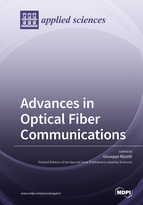Advances in Optical Fiber Communications
A special issue of Applied Sciences (ISSN 2076-3417). This special issue belongs to the section "Optics and Lasers".
Deadline for manuscript submissions: closed (28 February 2022) | Viewed by 14205
Special Issue Editor
Special Issue Information
Dear Colleagues,
Communication technologies based on fiber optics permeate our lives, and their role is increasingly vital to the modernization and advancement of our society toward an ever fairer and more efficient access to digital resources.
Optical transmission solutions range from high-speed networks based on coherent detection and advanced modulation formats for long-haul-level communications, to networks still relying on traditional intensity modulation and direct detection receivers for short-reach communications down to intra-data center scenarios. In between, there is a whole gamut of network architectures, providing different solutions for specific applications, targeting the minimization of the cost-per-bit as a trade-off between capacity and overall implementation cost, in order for operators to cope with the increasing traffic demand while still providing reasonable market accessibility.
This Special Issue will involve original results on novel optical communication system configurations that can help the transition toward higher data rates, even at very short transmission distances below 1 km. Topics of interest for this Special Issue include but are not limited to the following research areas:
- Coherent optical communication employing advanced modulation format for long-haul and short reach communications;
- Direct-detection-based long-haul and short-reach optical communication systems;
- Novel detection schemes;
- Multiband (C+L) optical networks;
- Network security and quality of services for optical communication;
- Novel optical/photonics components and silicon photonic integration;
- New modulation and coding schemes and digital signal processing;
- Multi-mode/few-mode fiber communication and/or equalization techniques;
- Optical metro/access networks;
- Data center interconnects.
Prof. Giuseppe Rizzelli
Guest Editor
Manuscript Submission Information
Manuscripts should be submitted online at www.mdpi.com by registering and logging in to this website. Once you are registered, click here to go to the submission form. Manuscripts can be submitted until the deadline. All submissions that pass pre-check are peer-reviewed. Accepted papers will be published continuously in the journal (as soon as accepted) and will be listed together on the special issue website. Research articles, review articles as well as short communications are invited. For planned papers, a title and short abstract (about 100 words) can be sent to the Editorial Office for announcement on this website.
Submitted manuscripts should not have been published previously, nor be under consideration for publication elsewhere (except conference proceedings papers). All manuscripts are thoroughly refereed through a single-blind peer-review process. A guide for authors and other relevant information for submission of manuscripts is available on the Instructions for Authors page. Applied Sciences is an international peer-reviewed open access semimonthly journal published by MDPI.
Please visit the Instructions for Authors page before submitting a manuscript. The Article Processing Charge (APC) for publication in this open access journal is 2400 CHF (Swiss Francs). Submitted papers should be well formatted and use good English. Authors may use MDPI's English editing service prior to publication or during author revisions.
Keywords
- fiber optic communications
- optical networks
- coherent detection
- advanced modulation
- DSP






